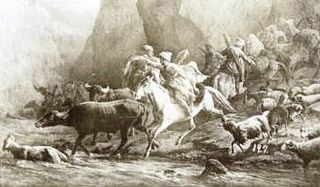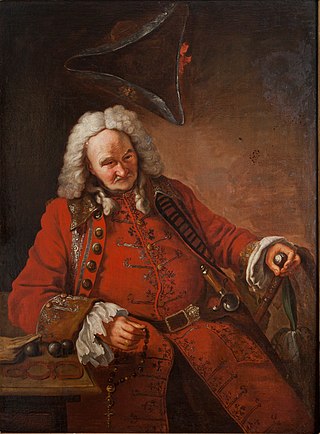Events
| | This section needs expansion. You can help by adding to it. (July 2016) |
- 7 August [ O.S. 27 July] 1722: The Russo-Persian War begins. [1] [2]
| Years in Russia: | 1719 1720 1721 1722 1723 1724 1725 |
| Centuries: | 17th century · 18th century · 19th century |
| Decades: | 1690s 1700s 1710s 1720s 1730s 1740s 1750s |
| Years: | 1719 1720 1721 1722 1723 1724 1725 |
Events from the year 1722 in Russia
| | This section needs expansion. You can help by adding to it. (July 2016) |
| | This section needs expansion. You can help by adding to it. (July 2016) |
| | This section needs expansion. You can help by adding to it. (July 2016) |

Peter I, commonly known as Peter the Great, was Tsar of all Russia from 1682, and the first Emperor of all Russia from 1721 until his death in 1725. He reigned jointly with his half-brother Ivan V until 1696. From this year, Peter was an absolute monarch who remained the ultimate authority. His methods were often harsh and autocratic.

Artemy Petrovich Volynsky was a Russian statesman and diplomat. His career started as a soldier but was rapidly upgraded to ambassador to Safavid Iran, and later as Governor of Astrakhan during the reign of Peter the Great. He was later accused of corruption and stripped of nearly all his powers, before Catherine I of Russia sent him to govern the vast Governorate of Kazan. Anna of Russia appointed Volynsky one of her three chief ministers in 1738. After beating the noted poet Vasily Trediakovsky, Volynsky was arrested on charges of conspiracy and misconduct. Volynsky's archenemy Ernst Johann von Biron had him sentenced to death and beheaded on 27 June 1740.

Count Fyodor Matveyevich Apraksin was one of the first Russian admirals, governed Estonia and Karelia from 1712 to 1723, was made general admiral (1708), presided over the Russian Admiralty from 1718 and commanded the Baltic Fleet from 1723.
Persian expedition or Persian campaign may refer to:

Tahmasp II was the penultimate Safavid shah of Iran, ruling from 1722 to 1732.

Vakhtang VI, also known as Vakhtang the Scholar, Vakhtang the Lawgiver and Ḥosaynqolī Khan, was a Georgian monarch of the royal Bagrationi dynasty. He ruled the East Georgian Kingdom of Kartli as a vassal of Safavid Persia from 1716 to 1724. One of the most important and extraordinary statesman of early 18th-century Georgia, he is known as a notable legislator, scholar, critic, translator and poet. His reign was eventually terminated by the Ottoman invasion following the disintegration of Safavid Persia, which forced Vakhtang into exile in the Russian Empire. Vakhtang was unable to get the tsar's support for his kingdom and instead had to permanently stay with his northern neighbors for his own safety. On his way to a diplomatic mission sanctioned by Empress Anna, he fell ill and died in southern Russia in 1737, never reaching Georgia.

Prince Boris Ivanovich Kurakin was the third permanent Russian ambassador abroad, succeeding Andrey Matveyev in The Hague and one of the closest associates of Peter the Great. He was also the tsar's brother-in-law, being married to Xenia, daughter of Feodor Abramovich Lopukhin and sister of Eudoxia Lopukhina.
The Russo-Persian Wars or Russo-Iranian Wars were a series of conflicts between 1651 and 1828, concerning Persia (Iran) and the Russian Empire. Russia and Persia fought these wars over disputed governance of territories and countries in the Caucasus. The main territories disputed were Aran, Georgia and Armenia, as well as much of Dagestan – generally referred to as Transcaucasia – and considered part of the Safavid Iran prior to the Russo-Persian Wars. Over the course of the five Russo-Persian Wars, the governance of these regions transferred between the two empires. Between the Second and Third Russo-Persian Wars, there was an interbellum period in which a number of treaties were drawn up between the Russian and the Persian Empires, as well as between both parties and the Ottoman Empire. Ottoman interest in these territories further complicated the wars, with both sides forming alliances with the Ottoman Empire at different points throughout the wars. Following the Treaty of Turkmenchay, which concluded the Fifth Russo-Persian War, Persia ceded much of its Transcaucasian territory to the Russian Empire.

Lekianoba was the name given to sporadic forays by Northeast Caucasian people into Georgia from the 16th to the 19th centuries. The term is derived from Leki, by which the Georgians knew the Lezgin people, with the suffix –anoba, which designates attribution. The references to these raids appear in the epic poetry of the Avars; the names of rulers who lead the most devastating attacks, Umma-Khan, Nursal-Bek, and Mallachi, are mentioned in Georgian sources.

The Baku Khanate, was a khanate under Iranian suzerainty, which controlled the city of Baku and its surroundings from 1747 to 1806.

Danylo Apostol (1654–1734), was a Hetman of Zaporizhian Host from 1727 to 1734.

The Russo-Persian War of 1722–1723, known in Russian historiography as the Persian campaign of Peter the Great, was a war between the Russian Empire and Safavid Iran, triggered by the tsar's attempt to expand Russian influence in the Caspian and Caucasus regions and to prevent its rival, the Ottoman Empire, from territorial gains in the region at the expense of declining Safavid Iran.
The Persian expedition of Catherine the Great in 1796, like the Persian expedition of Peter the Great (1722-1723), was one of the Russo-Persian Wars of the 18th century which did not entail any lasting consequences for either belligerent.

Heraclius I or Nazar Alī Khān (1642–1709), of the Bagrationi dynasty, was a Georgian monarch who ruled the kingdoms of Kakheti and Kartli (1688–1703) under the protection of the Safavid dynasty of Iran.

Tsarevna Catherine Ivanovna of Russia was a daughter of Tsar Ivan V and Praskovia Saltykova, eldest sister of Empress Anna of Russia and niece of Peter the Great. By her marriage, she was a Duchess of Mecklenburg-Schwerin.
Peter the Great's capture of Rasht, occurred between December 1722 and late March 1723 amidst the successful spree of campaigns of Peter the Great during the Russo-Persian War (1722-1723). The capture of Rasht brought the Caspian Sea town alongside the rest of Gilan into Russian possession for a decade, until the Treaty of Resht of 1732, when they would be returned.
Mikhail Athanas'evich Matyushkin was a general of the Russian Empire during the reign of Peter the Great. He is noted amongst others for his participation in the Russo-Persian War of 1722-1723, during which, in 1723, he captured the Persian city of Baku after a siege of four days. He was also in charge of the overal conquest of Gilan province in the same year.
Events from the year 1804 in Russia

Ivan Aleksandrovich Balakirev was a court jester to Peter I of Russia.
Events from the year 1723 in Russia
![]() Media related to 1722 in the Russian Empire at Wikimedia Commons
Media related to 1722 in the Russian Empire at Wikimedia Commons